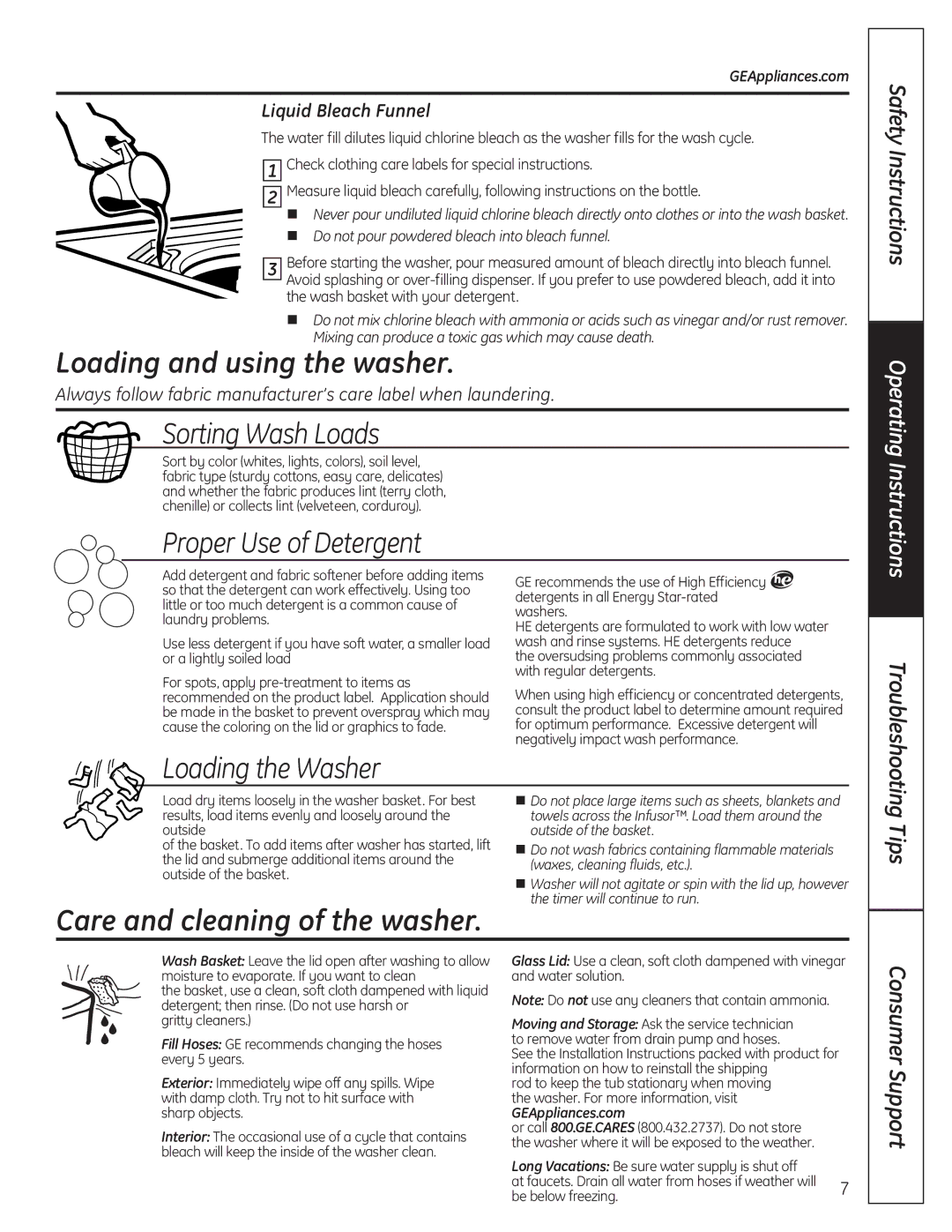
GEAppliances.com
Liquid Bleach Funnel
The water fill dilutes liquid chlorine bleach as the washer fills for the wash cycle.
1Check clothing care labels for special instructions.
2Measure liquid bleach carefully, following instructions on the bottle.
n never pour undiluted liquid chlorine bleach directly onto clothes or into the wash basket. n do not pour powdered bleach into bleach funnel.
3 Before starting the washer, pour measured amount of bleach directly into bleach funnel. Avoid splashing or
ndo not mix chlorine bleach with ammonia or acids such as vinegar and/or rust remover. mixing can produce a toxic gas which may cause death.
Loading and using the washer.
always follow fabric manufacturer’s care label when laundering.
Sorting Wash Loads
Sort by color (whites, lights, colors), soil level, fabric type (sturdy cottons, easy care, delicates) and whether the fabric produces lint (terry cloth, chenille) or collects lint (velveteen, corduroy).
Proper use of detergent
Add detergent and fabric softener before adding items so that the detergent can work effectively. Using too little or too much detergent is a common cause of laundry problems.
Use less detergent if you have soft water, a smaller load or a lightly soiled load
For spots, apply
GE recommends the use of High Efficiency ![]() detergents in all Energy
detergents in all Energy
washers.
HE detergents are formulated to work with low water wash and rinse systems. HE detergents reduce
the oversudsing problems commonly associated with regular detergents.
When using high efficiency or concentrated detergents, consult the product label to determine amount required for optimum performance. Excessive detergent will negatively impact wash performance.
Loading the Washer
Load dry items loosely in the washer basket. For best results, load items evenly and loosely around the outside
of the basket. To add items after washer has started, lift the lid and submerge additional items around the outside of the basket.
Care and cleaning of the washer.
ndo not place large items such as sheets, blankets and towels across the Infusor™. Load them around the outside of the basket.
ndo not wash fabrics containing flammable materials (waxes, cleaning fluids, etc.).
nWasher will not agitate or spin with the lid up, however the timer will continue to run.
Wash Basket: Leave the lid open after washing to allow moisture to evaporate. If you want to clean
the basket, use a clean, soft cloth dampened with liquid detergent; then rinse. (Do not use harsh or
gritty cleaners.)
Fill Hoses: GE recommends changing the hoses every 5 years.
Exterior: Immediately wipe off any spills. Wipe with damp cloth. Try not to hit surface with sharp objects.
Interior: The occasional use of a cycle that contains bleach will keep the inside of the washer clean.
Glass Lid: Use a clean, soft cloth dampened with vinegar and water solution.
Note: Do not use any cleaners that contain ammonia.
Moving and Storage: Ask the service technician to remove water from drain pump and hoses.
See the Installation Instructions packed with product for information on how to reinstall the shipping
rod to keep the tub stationary when moving the washer. For more information, visit
GEAppliances.com
or call 800.GE.CARES (800.432.2737). Do not store the washer where it will be exposed to the weather.
Long Vacations: Be sure water supply is shut off
at faucets. Drain all water from hoses if weather will 7 be below freezing.
Safety Instructions
Operating Instructions
Troubleshooting Tips
Consumer Support
